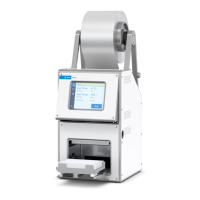PlateLoc Thermal Microplate Sealer
Frequently asked questions
14 Reference for Optimal Thermal Microplate Sealing
Microplate height
Q
Can low- profile high- density microplates (for example, 1536- well microplates)
or tall deep- well microplates be sealed with the PlateLoc Sealer?
A
Yes. Low- profile microplates tend to bend, so you must match the microplate
with the appropriate microplate support to prevent this from happening. The
sample well surface and the sample well bottoms should be rigid and parallel.
Inserts (see “Insert thickness” on page 4) are designed to assist in these
circumstances. The hot plate is mounted in the top of the sealing chamber and
descends to the appropriate height for sealing, automatically adjusting to the
microplate height. Tall labware, such as deep- well microplates as tall as 2.5 in
(63.5 mm), can be accommodated. High- volume storage and collection
microplates exceeding 2.5 in are not compatible with the PlateLoc Sealer (for
example, Porvair Sciences 48- well microplates of 7 and 10 mL sample volume,
etc.).
How does thermal sealing work?
Q
How does thermal microplate seal bond to the microplate? Will the glue
contaminate my samples? Will it work with DMSO or organic solvents?
A
Hot melt adhesives (HMAs, also referred to as thermoplastic adhesives) are
solid at room temperature, become molten when heated, and adhesion develops
as the melt solidifies while it cools. Most hot melt adhesives achieve 50% of the
bond strength after one minute, 75% after one hour, and 100% after one day.
Chemical resistance will vary based on the formulation and additives. For
example, for ethylene vinyl acetate copolymer (EVA), chemical resistance varies
from poor (for aromatic hydrocarbons such as benzene or halogenated
hydrocarbons), to good (for oils and greases), to very good (for dilute acids,
alkalis, aliphatic hydrocarbons, and alcohols). Confirm that any seal you use is
compatible with your samples (see next question).
Figure 11 Hypothetical thermal microplate sealing film structure.
Optional Top Coating
(e.g. Primer for Printing)
Backing / Support Layer
(e.g. Aluminum or Clear Polymer Laminates)
HMA (Hot Melt Adhesive) Layer
(e.g. EVA with additives, similar to “Hot Melt Glue Stick”

